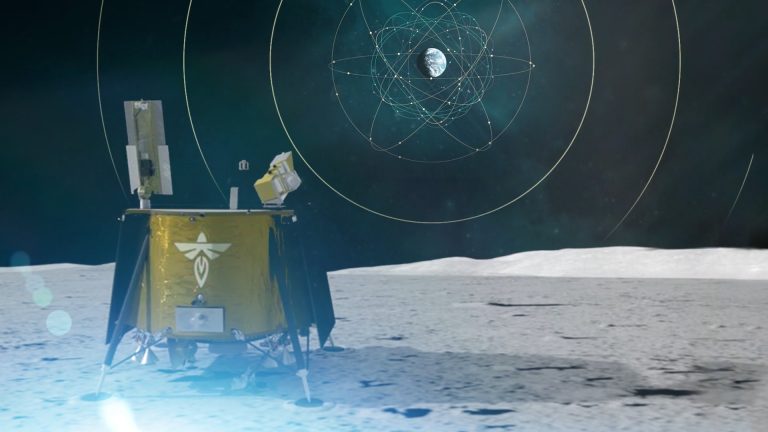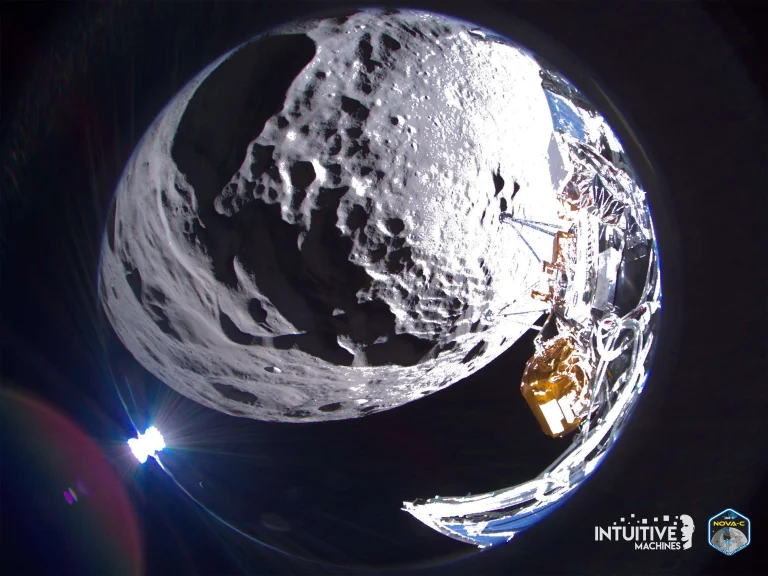NASA成功在月球上获取GPS信号
NASA和意大利航天局于3月3日创造了历史,月球GNSS接收器实验(LuGRE)成为第一个在月球表面获取并跟踪地球导航信号的技术演示项目。

NASA和意大利航天局于3月3日创造了历史,月球GNSS接收器实验(LuGRE)成为第一个在月球表面获取并跟踪地球导航信号的技术演示项目。


See Explanation. Clicking on the picture will download the highest resolution version available.
请参阅说明。单击图片将下载可用的最高分辨率版本。

在NASA的CLPS(商业月球有效载荷服务)计划首次成功交付后,NASA的新科学仪器和技术演示50多年来首次在月球上运行。

2023年11月18日 Planet Earth from Orion Image Credit: NASA, Artemis I Explanation: One year ago a Space Launch System rocket left planet Earth on November 16, 2022 at 1:47am EST carrying the Orion spacecraft on the Artemis I mission, the first integrated test of NASA’s deep space exploration systems. Over an hour after liftoff from Kennedy Space Center’s historic Launch Complex 39B, one of Orion’s external video cameras captured this view of its new perspective from space. In the foreground are Orion’s Orbital Maneuvering System engine and auxillary engines, at the bottom of the European Service Module. Beyond one of the module’s 7-meter long extended solar array wings lies the spacecraft’s beautiful home world. Making close flybys of the lunar surface and reaching a retrograde orbit…

The Artemis II crew and teams with NASA’s Exploration Ground Systems Program successfully completed on Sept. 20, the first in a series of integrated ground system tests at NASA’s Kennedy Space Center in Florida in preparation for the upcoming mission around the Moon. NASA astronauts Reid Wiseman, Victor Glover, and Christina Koch, along with Canadian Space Agency astronaut Jeremy Hansen, practiced the procedures they will undergo on launch day, from putting on their Orion crew survival system spacesuits to traveling to the launch pad and up the mobile launcher, to prepare for their ride to space. Artemis II is the first crewed mission under Artemis and will test all of the Orion spacecraft’s systems with astronauts aboard before future missions to the Moon. Text credit:…

沙克尔顿撞击坑的新拼接图 影像来源:Mosaic created by LROC (Lunar Reconnaissance Orbiter) and ShadowCam teams with images provided by NASA/KARI/ASU 沙克尔顿撞击坑的一幅新拼接图展示了两台月球轨道相机的力量,它们协同工作,揭示了月球南极地区前所未有的细节。 这幅拼接图是由2009年开始运行的月球侦查轨道器照相机(LROC)和2022年8月发射的韩国航空宇宙研究院(KARI)达努里(Danuri)航天器上搭载的NASA仪器ShadowCam拍摄的图像拼接而成。ShadowCam是由马林太空科学系统和亚利桑那州立大学开发。 LROC可以捕捉到月球表面的详细图像,但拍摄月球上从未受到阳光直射的阴影部分的能力有限,这些阴影部分被称为永久阴影区域。ShadowCam的感光度是LROC的200倍,可以在极低光照条件下成功运行,揭示LROC看不到的特征和地形细节。ShadowCam依靠月球地质特征或地球反射的阳光来拍摄阴影中的图像。 然而,ShadowCam的感光度使其无法拍摄到阳光直接照射的月球部分的图像,从而产生过曝的结果。每台相机都针对月球两极附近的特定照明条件进行了优化,分析人员可以将这两台仪器的图像结合起来,创建一张月球最亮和最暗部分的地形和地质特征的综合视觉地图。在这幅拼接图中,永久阴影区域,如沙克尔顿撞击坑的内部地面和峭壁,由于阴影相机的图像,可以如此详细地看到。相比之下,这幅拼接图中阳光照射的区域,比如撞击坑的边缘和侧面,是LROC收集的图像的产物。 有了ShadowCam,NASA可以比以前更详细地拍摄月球的永久阴影区域的图像,让科学家更好地观察月球南极区域。该地区从未被人类勘探过,由于被认为含有冰沉积物或其他冻结挥发物,因此对科学和勘探非常感兴趣。科学家们认为,月球上的冰层已经存在了数百万或数十亿年,研究样本的能力可以进一步加深我们对月球和太阳系如何演化的理解。冰沉积物也可以作为一种重要的勘探资源,因为它们由氢和氧组成,可以用于火箭燃料或生命支持系统。 月球南极地区更完整的地图对未来的表面探测工作很有价值,比如VIPER(挥发性物质极地探测车)和阿尔忒弥斯任务,这些任务将使人类重返月球表面,并在月球上建立长期存在。

“From an early age, I wanted to be an astronaut. I remember going to Kennedy Space Center Visitor Center when I was 7 on a family trip, and we got to see the rockets in the Rocket Garden and learn all about the Moon landings. I had no idea that humanity had ever been in space, much less landed on the Moon. When my family moved from Colombia to the United States when I was 10 years old, I remember thinking, ‘Maybe I have an opportunity to work in the space industry when I get older now that I live here.’ “Back then, we didn’t have Google, so I went to the library because I wanted to find out, ‘How do you become an astronaut?’…

In this image from April 2023, NASA’s Moonikin Campos, a manikin that flew on the Artemis I flight test beyond the Moon, enjoys a quiet moment during acceleration sled testing at Wright-Patterson Air Force Base in Ohio. Engineers put Moonikin Campos through acceleration sled testing to simulate contingency landings. Sled testing is a common method of testing restraint systems like automotive seats and seat belts to investigate their performance in collision situations. The tests are informing engineers’ understanding of what the experience of flying inside the agency’s Orion spacecraft will be like on crewed missions to the Moon beginning with Artemis II. During testing, the manikin wore the Orion Crew Survival System (OCSS) with a motion tracker on its forehead. Artemis astronauts will wear the…

One of three specially designed, fully electric, environmentally friendly crew transportation vehicles for Artemis missions sits at Launch Pad 39B at NASA’s Kennedy Space Center in Florida on July 11, 2023. These zero-emission vehicles, manufactured by Canoo Technologies Inc., will take Artemis crews on the final Earth-bound leg of their journey to the Moon before boarding their rocket and spacecraft. The new vehicles are customized to accommodate NASA’s unique specifications for Artemis missions while also paying homage to the legacy of the agency’s human spaceflight and space exploration efforts. Many aspects of the design, from the interior and exterior markings to the color of the vehicles to the wheel wells, were chosen by a creative team that included the Artemis launch director and representatives from…